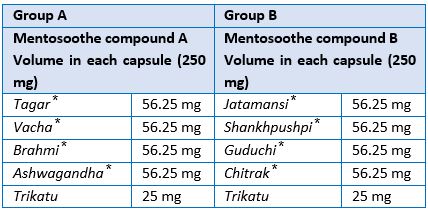Clinical study to evaluate the efficacy of Mentosoothe Compound in the management of Attention Deficit / Hyperactivity Disorder
DOI:
https://doi.org/10.21760/jaims.8.7.6Keywords:
ADHD, Unmada, Mentosoothe Compound, MedhyaAbstract
Introduction: DSM-5 defines Attention-Deficit/Hyperactivity Disorder as having a persistent pattern of hyperactivity or inattention. This affects social, emotional, cognitive, and academic performance, behavioural skills in children and adolescents. The suffering child should have more than 6 symptoms of a particular type. Due to aetiology of Dhee Dhriti and Smriti, which results in imbalance of Kala and Karma and leads to incorrect interaction of the senses with their aims (Asatmyendriyartha Samyoga), gives rise to inattention, hyperactivity and impulsivity. Considering the nature of symptomatologic manifestation, it can be correlated with Unmada, more specifically Vata-Pittaja Unmada. Ayurveda addresses ADHD with both internal medicines and external therapies. Mentosoothe compound is such a polyherbal compound it contains Medhya, Balya, Deepana and Rasayana drugs in extract form. Aim of the present study to evaluate the efficacy of mentosoothe compound in the management of Attention-Deficit/Hyperactivity Disorder. Objective of the study is to promote cognitive performance with improvement in the quality of life by providing an effective and safe treatment option. Materials and Methods: The present study will be conducted as a randomized clinical study including minimum 40 patients, divided into two groups. Mentosoothe compound A and Mentosoothe compound B will be given to groups with fixed dosages. Assessment will be done on every 15th day during 2 months of clinical trial and final follow up will be done one month after completion of clinical trial. Result: The results will give the data on comparative effectiveness of the Mentosoothe compounds on ADHD. Discussion and Conclusion: The outcome of this trial will render a way forward to effective management of ADHD in children.
Downloads
References
Choudhary, Kuldeep, et al. "A Protocol for Systematic Review to Study the Efficacy and Safety of Ayurveda Intervention in Children and Adolescent with Attention Deficit Hyperactivity Disorder." (2019)
Fagne MS, Thakre T, Bhaskaran JK. Role of Ayurveda in Attention Deficit Hyperactive Disorder (ADHD) A Case Study. Journal of Research in Traditional Medicine. 2020 Jul 7;4(5):128-.
Saini A. The Pattern of Psychiatric Morbidity in an Out-Patient Child Psychiatry Clinic: A Study From A Tertiary Care Centre In Jaipur, North India.
Yadav K, Yadav Y, Solanki G, Gupta K, Gupta J, Saini A, Patel B, Dube A. Neural Dynamics of Theta Wave in Children with Attention Deficit Hyper activity Disorder.
Paul k Vinod, Bagga Arvind; 2019; Ghai Essential pediatrics, Ninth edition CBS publishers and distributors pvt. Limited 4819/XI Prahlad street, 24 Ansari road, Dariyaganj, New Delhi 110002 page no.55.
Hoseini, Bibi Leila, et al. "Attention deficit hyperactivity disorder (ADHD) in children: a short review and literature." (2014): 443-450.
Yadav K, Yadav Y, Solanki G, Gupta K, Gupta J, Saini A, Patel B, Dube A. Neural Dynamics of Theta Wave in Children with Attention Deficit Hyper activity Disorder.
Singhal HK, Neetu AK, Rai M. Ayurvedic approach for improving reaction time of attention deficit hyperactivity disorder affected children. Ayu. 2010 Jul;31(3):338.
Choudhary, Kuldeep, et al. "A Protocol for Systematic Review to Study the Efficacy and Safety of Ayurveda Intervention in Children and Adolescent with Attention Deficit Hyperactivity Disorder." (2019).
Elliott W, Chan J. Viloxazine Extended-Release Capsules (Qelbree). Internal Medicine Alert. 2021 May 1;43(9).
Gameti, Rahul, et al. "Ayurvedic management of ADHD (Attention-Deficit and Hyperactivity Disorder) with Panchendriya Viverdhan Tail Nasya - A Case Study." (2017).
Sharma Pandit Hemraj, Vidyotini Hindi Commentary Kashyap Samhita, Sutra Sthan, Vedna-adhyay, Chaukhambha Sanskrit Sansthan, Varanasi, Reprint 2018, 25/20 shlok , Pg. no. 50.
Choudhary, Kuldeep, et al. "A Protocol for Systematic Review to Study the Efficacy and Safety of Ayurveda Intervention in Children and Adolescent with Attention Deficit Hyperactivity Disorder." (2019).
Singhal HK, Neetu AK, Rai M. Ayurvedic approach for improving reaction time of attention deficit hyperactivity disorder affected children. Ayu. 2010 Jul;31(3):338.
Pawar, V.S.; Anup, A.; Shrikrishna, B.; Shivakumar, H. Antidepressant–like effects of Acorus calamus in forced swimming and tail suspension test in mice. Asian Pac. J. Trop. Biomed. 2011, 1, S17–S19.
Naderi, G.A.; Khalili, M.; Karimi, M.; Soltani, M. The effect of oral and intraperitoneal administration of Acorus calamus L. extract on learning and memory in male rats. J. Med. Plant 2010, 2, 46–56
Singh HK and Dharwan BN. Neuropsychopharmacological effects of the Ayurvedic nootropic Bacopa monniera Linn (Brahmi). Indian Journal of Pharmacology 1997; 29:S359-S365.
Meena, Mukesh Kumar. "Attention-Deficit Hyperactivity Disorder (ADHD) in Children through Ayurveda." (2017).
Mishra PK, Math PD. Brief Overview on effect of Ashwagandha on Attention Deficit Hyperactivity Disorder in Children.
Chavan GS, Rathi RB. A Short Review on Unnmad wsr to Attention Deficit Hyperactivity Disorder (ADHD).
Niraj S, Varsha S. Role of Medhya Rasayanas (Nootropic Drugs) in Developmental Disabilities of Children. Mental retardation.;25:30.
Husain A, Kaushik A, Awasthi H, Singh DP, Khan R, Mani D. Immunomodulatory and antioxidant activities of fresh juice extracts of Brahmi and Guduchi. Indian J Tradit Knowl. 2017 Jul 1;16(3):498-505.
Niraj S, Varsha S. Role of Medhya Rasayanas (Nootropic Drugs) in Developmental Disabilities of Children. Mental retardation.;25:30.
Tilak JC, Adhikari S, Devasagayam TP. Antioxidant properties of Plumbago zeylanica, an Indian medicinal plant and its active ingredient, plumbagin. Redox report. 2004 Aug 1;9(4):219-27.
Datta S, Mishra R. Plumbago zeylinica Linn. (Chitrak) - Review as Rasayan (rejuvenator/antiaging). Int J Res Pharm Biomed Sci. 2012;3(1):250-67.
Kaushik R. Trikatu. A combination of three bioavailability enhancers. International Journal of Green Pharmacy. 2018;12(3).















